13th NOV 1901 FOUR LANGUAGE PANEL AND FOUR CORNER SERIAL NUMBER RS. 10/- WITH DIFFERENT INDIAN LANGUAGES
MUSEUM
British India Issues
British India Issues commence with the Paper Currency Act of 1861 which gave the Government the monopoly of note issue in India. The management of paper currency across the geographical expanse of the Indian sub-continent was a task of considerable proportions. Initially the Presidency Banks were appointed as agents to promote the circulation of these notes in view of their existing infrastructure. The Act of 1861 authorised the Presidency Banks to enter into agreements with the Secretary of State for becoming agents for the issue, payment and exchange of promissory notes of the Government of India. The problem of redemption of these notes over vast expanses of the Indian sub-continent led to the concept of 'Currency Circles', where these notes were legal tender.
These Currency Circles increased in number as the Government progressively took over the work. The agency agreements with the Presidency Banks were finally terminated in 1867. The Management of Paper Currency was subsequently, in turn, entrusted to the Mint Masters, the Accountant Generals and the Controller of Currency.
Victoria Portrait Series
The first set of British India notes were the 'Victoria Portrait' Series issued in denominations of 10, 20, 50, 100, 1000. These were unifaced, carried two language panels and were printed on hand-moulded paper manufactured at the Laverstock Paper Mills (Portals). The security features incorporated the watermark (GOVERNMENT OF INDIA, RUPEES, two signatures and wavy lines), the printed signature and the registration of the notes.
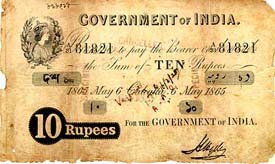 Rupees Ten 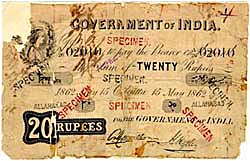 Rupees Twenty 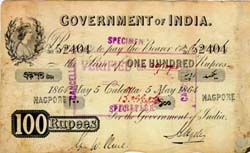 Rupees Hundred
British India Notes facilitated inter-spatial transfer of funds. As a security precaution, notes were cut in half. One set was sent by post. On confirmation of receipt, the other half was despatched by post.
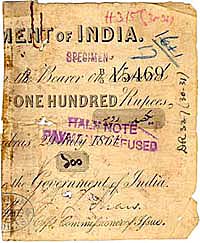 Half note
Underprint Series
The Victoria Portrait series was withdrawn in the wake of a spate of forgeries and replaced by the unifaced 'Underprint Series' which were introduced in 1867. In deference to public demand, notes in the denomination of Rupees Five were introduced. Initially, notes were legally encashable only in the Currency Circle in which they were issued; however, between 1903 an 1911, notes of denomination 5, 10, 50 and 100 were 'universalised', i.e. were legally encashable outside the Currency Circle of Issue.
The Underprint Series notes were printed on moulded paper and carried 4 language panels (Green Series). The languages differed as per the currency circle of Issue. Language panels were increased to 8 in the Red Series. The improved security features included a wavy line watermark, the manufacturer's code in the watermark (the source of much confusion in dating), guilloche patterns and a coloured underprint.
This series remained largely unchanged till the introduction of the 'King's Portrait' series which commenced in 1923.
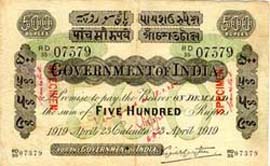 Green Underprint - Rupees Five Hundred 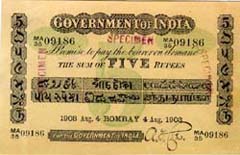 Green Underprint - Rupees Five 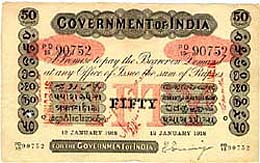 Red Underprint - Rupees Fifty
Small Denomination Notes
The introduction of small denomination notes in India was essentially in the realm of the exigent. Compulsions of the first World War led to the introduction of paper currency of small denominations. Rupee One was introduced on 30th November, 1917 followed by the exotic Rupees Two and Annas Eight. The issuance of these notes was discontinued on 1st January, 1926 on cost benefit considerations. These notes first carried the portrait of King George V and were the precursors of the 'King's Portrait' Series which were to follow.
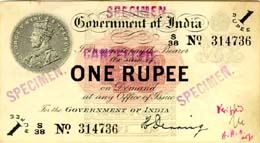 Rupee One - Obverse 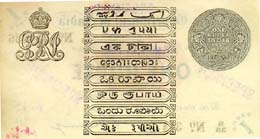 Rupee One -Reverse 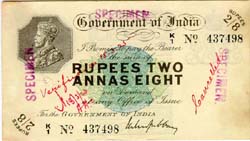 Rupees Two and Annas Eight - Obverse
King's Portrait Series
Regular issues of this Series carrying the portrait of George V were introduced in May, 1923 on a Ten Rupee Note. The King's Portrait Motif continued as an integral feature of all Paper Money issues of British India. Government of India continued to issue currency notes till 1935 when the Reserve Bank of India took over the functions of the Controller of Currency. These notes were issued in denominations of Rs 5, 10, 50, 100, 500, 1000, 10,000.
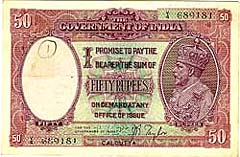 Rupees Fifty 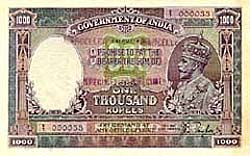 Rupees One Thousand 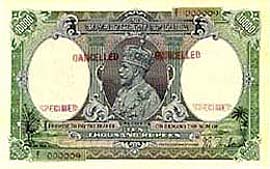 Rupees Ten Thousand
With the establishment of the Currency Note Press at Nasik in 1928, currency notes came to be progressively printed in India. By 1932 the Nasik Press was printing the entire spectrum of India currency notes. The improved security features were changed watermarks, intricate portrait designs and multicoloured printing.
British India: Reserve Bank Issues
The Reserve Bank of India was formally inaugurated on Monday, April 1, 1935 with its Central Office at Calcutta.
 The first Central Office of the Reserve Bank of India
It began operations by taking over from the Government the functions hitherto performed by the Controller of Currency and from the Imperial Bank the management of Government Accounts and Public Debt. The existing Currency Offices in Calcutta, Bombay, Madras, Rangoon, Karachi, Lahore and Cawnpore became the branches of the Issue Department of the Bank. (It was not then considered necessary to have an office in Delhi.).
Section 22 of the RBI Act, 1934, empowered it to continue issuing Government of India notes till its own notes were ready for issue. The Central Board of the Bank recommended that the Bank notes retain the general size, appearance and design of the existing notes, albeit with modifications.
Notes with the portrait of Edward VIII were scheduled for release in the summer of '37. But Edward's heart had its reasons and his abdication, at levels mundane, delayed the Bank's issues to January 1938 when the first Five Rupee note was issued bearing the portrait of George VI.
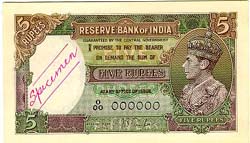 Rupees Five - First Note issued by Reserve Bank of India
This was followed by Rs 10 in February, Rs 100 in March and Rs 1,000 and Rs 10,000 in June 1938.
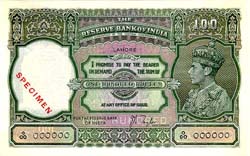 Rupees One Hundred 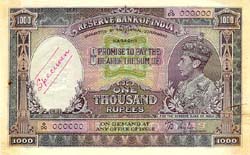 Rupees One Thousand 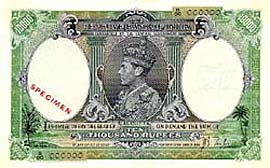 Rupees Ten Thousand
The first Governor, Sir Osborne Smith did not sign any bank notes; the first Reserve Bank issues were signed by the second Governor, Sir James Taylor.
In August 1940, the one-rupee note was reintroduced, once again as a war time measure, as a Government note with the status of a rupee coin, in terms of the Currency Ordinance of 1940 (IV of 1940). The issuance of Rs 2 and Annas 8 was contemplated but Rs 2 was introduced instead on 3rd March , 1943.
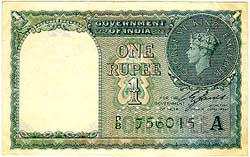 Rupee One Obverse 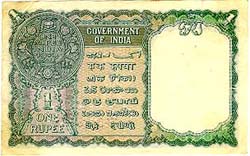 Rupee One Reverse 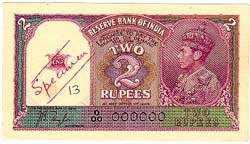 Rupees Two
During the war, Japanese Operations to destabilise Indian currency involved high quality forgeries, largely of Re 10 notes signed by Governor C.D. Deshmukh.
 Sir C. D. Deshmukh
This necessitated a change in the watermark and obverse design from the profile portrait of George VI to his full frontal portrait. As an added security feature, the security thread was introduced for the first time in India.
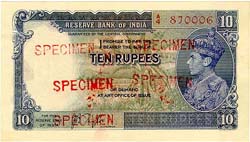 George VI Profile 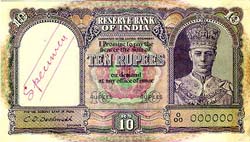 George VI Frontal
The George VI series continued till 1947 and thereafter as a frozen series till 1950 when post independence notes were issued.
|
MUSEUM
Early Issues
Paper Money, as we know it today, was introduced in India in the late Eighteenth Century. This was a period of intense political turmoil and uncertainty in the wake of the collapse of the Mughal Empire and the advent of the colonial powers. The changed power structure, the upheavals, wars, and colonial inroads led to the eclipse of indigenous bankers, as large finance in India moved from their hands to Agency Houses who enjoyed state patronage. Many agency houses established banks.
Among the early issuers, the General Bank of Bengal and Bahar (1773-75) was a state sponsored institution set up in participation with local expertise. Its notes enjoyed government patronage. Though successful and profitable, the bank was officially wound up and was short lived. The Bank of Hindostan (1770-1832) was set up by the agency house of Alexander and Company was particularly successful. It survived three panic runs on it. The Bank of Hindostan finally went under when its parent firm M/s Alexander and Co. failed in the commercial crisis of 1832. Official patronage and the acceptance of notes in the payment of revenue was a very important factor in determining the circulation of bank notes. Wide use of bank notes, however, came with the note issues of the semi-government Presidency Banks, notably the Bank of Bengal which was established in 1806 as the Bank of Calcutta with a capital of 50 lakh sicca rupees. These banks were established by Government Charters and had an intimate relationship with the Government. The charter granted to these banks accorded them the privilege of issuing notes for circulation within their circles.
Notes issued by the Bank of Bengal can broadly be categorised in 3 broad series viz: the 'Unifaced' Series, the 'Commerce' Series and the 'Britannia' Series. The early notes of the Bank of Bengal were unifaced and were issued as one gold mohur (sixteen sicca rupees in Calcutta) and in denominations deemed convenient in the early 19th Century, viz., Rs. 100, Rs. 250, Rs. 500, etc.
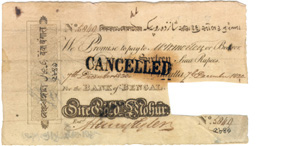 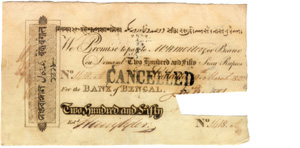 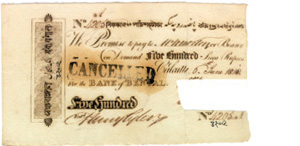
Unifaced Notes of the Bank of Bengal
The Bank of Bengal notes later introduced a vignette represented an allegorical female figure personifying 'Commerce' sitting by the quay. The notes were printed on both sides. On the obverse the name of the bank and the denominations were printed in three scripts, viz., Urdu, Bengali and Nagri. On the reverse of such notes was printed a cartouche with ornamentation carrying the name of the Bank. Around the mid nineteenth century, the motif 'Commerce' was replaced by 'Britannia'. The note had intricate patterns and multiple colours to deter forgeries.
Commerce Series
Brittania Series
The second Presidency Bank was established in 1840 in Bombay, which had developed as major commercial centre. The Bank had a checkered history. The crisis resulting from the end of the speculative cotton boom led to the liquidation of Bank of Bombay in 1868. It was however reconstituted in the same year. Notes issued by the Bank of Bombay carried the vignettes of the Town Hall and others the statues of Mountstuart Elphinstone and John Malcolm.
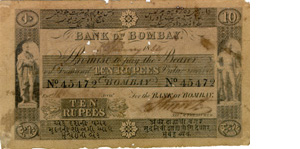 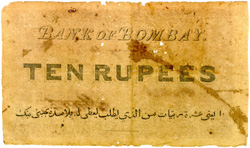
Note issued by the Bank of Bombay
The Bank of Madras established in 1843 was the third Presidency Bank. It had the smallest issue of bank notes amongst Presidency Banks. The notes of the Bank of Madras bore the vignette of Sir Thomas Munroe, Governor of Madras (1817-1827).
The other private banks which issued bank notes were the Orient Bank Corporation established in Bombay as the Bank of Western India in 1842. Its notes featured the Bombay Town Hall as vignette. The Commercial Bank of India established in 1845 in Bombay (also an Exchange Bank) issued exotic notes with an interblend of Western and Eastern Motifs. The bank failed in the crash of 1866. The paper currency Act of 1861 divested these banks of the right to note issue; the Presidency Banks were, however, given the free use of Government balances and were initially given the right to manage the note issues of Government of India.
BANK NOTES
Security Features of Indian Banknotes
Watermark
 The Mahatma Gandhi Series of banknotes contain the Mahatma Gandhi watermark with a light and shade effect and multi-directional lines in the watermark window.
Security Thread
Rs.1000 notes introduced in October 2000 contain a readable, windowed security thread alternately visible on the obverse with the inscriptions ‘Bharat’ (in Hindi), ‘1000’ and ‘RBI’, but totally embedded on the reverse. The Rs.500 and Rs.100 notes have a security thread with similar visible features and inscription ‘Bharat’ (in Hindi), and ‘RBI’. When held against the light, the security thread on Rs.1000, Rs.500 and Rs.100 can be seen as one continuous line. The Rs.5, Rs.10, Rs.20 and Rs.50 notes contain a readable, fully embedded windowed security thread with the inscription ‘Bharat’ (in Hindi), and ‘RBI’. The security thread appears to the left of the Mahatma's portrait. Notes issued prior to the introduction of the Mahatma Gandhi Series have a plain, non-readable fully embedded security thread. Latent Image On the obverse side of Rs.1000, Rs.500, Rs.100, Rs.50 and Rs.20 notes, a vertical band on the right side of the Mahatma Gandhi’s portrait contains a latent image showing the respective denominational value in numeral. The latent image is visible only when the note is held horizontally at eye level. Microlettering This feature appears between the vertical band and Mahatma Gandhi portrait. It contains the word ‘RBI’ in Rs.5 and Rs.10. The notes of Rs.20 and above also contain the denominational value of the notes in microletters. This feature can be seen better under a magnifying glass. Intaglio Printing The portrait of Mahatma Gandhi, the Reserve Bank seal, guarantee and promise clause, Ashoka Pillar Emblem on the left, RBI Governor's signature are printed in intaglio i.e. in raised prints, which can be felt by touch, in Rs.20, Rs.50, Rs.100, Rs.500 and Rs.1000 notes. Identification Mark A special feature in intaglio has been introduced on the left of the watermark window on all notes except Rs.10/- note. This feature is in different shapes for various denominations (Rs. 20-Vertical Rectangle, Rs.50-Square, Rs.100-Triangle, Rs.500-Circle, Rs.1000-Diamond) and helps the visually impaired to identify the denomination. Fluorescence Number panels of the notes are printed in fluorescent ink. The notes also have optical fibres. Both can be seen when the notes are exposed to ultra-violet lamp. Optically Variable Ink This is a new security feature incorporated in the Rs.1000 and Rs.500 notes with revised colour scheme introduced in November 2000. The numeral 1000 and 500 on the obverse of Rs.1000 and Rs.500 notes respectively is printed in optically variable ink viz., a colour-shifting ink. The colour of the numeral 1000/500 appears green when the note is held flat but would change to blue when the note is held at an angle. See through Register The small floral design printed both on the front (hollow) and back (filled up) of the note in the middle of the vertical band next to the Watermark has an accurate back to back registration. The design will appear as one floral design when seen against the light. Legal provisions against counterfeiting Printing and circulation of forged notes are offences under Sections 489A to 489E of the Indian Penal Code and are punishable in the courts of law by fine or imprisonment or both. Click here for security features of currency notes Search ResultsBanknotes of Burma: BANKNOTES OF BURMA
banknotesofburma.blogspot.com/2011/07/banknotes-of-burma.html
Aug 5, 2011 - The Burma State Bank issued notes for 1, 5, 10 and 100 rupees in 1944 ... Six different banknote issuer names were used since Burma has ... Locallanguages were added to the language panel of each circle's .... There are serial numbers at four places; on top left and right corners ... 10 RUPEES (1901-09).Reserve Bank of India - Frequently Asked Questions
https://rbi.org.in/scripts/FAQView.aspx?Id=39
Language हिंदी ... For a common person, money simply means currency and coins. ... Banknotes in India are currently being issued in the denomination of ₹ 10, ... The OneRupee notes issued under the Currency Ordinance, 1940 are also ..... Each of these banknote bears a distinctive serial number along with a prefix ...
Missing:
Reserve Bank of India - Bank Notes - Annual Report
https://www.rbi.org.in/scripts/ic_banknotessecurity.aspx
Language हिंदी ... The Rs.500 and Rs.100 notes have a security thread with similar visible features and inscription ... has been introduced on the left of the watermark window on all notes except Rs.10/- note. ... Number panels of the notes are printed in fluorescent ink. ... Click here for security features of currency notes.
Missing:
(10); TEN RUPEE NOTES - coins and more
exclusivecoins.blogspot.com/.../did-you-know-series-10-ten-rupee-notes....
Dec 29, 2011 - The serial number of the Note is below the window displaying his portrait and ... The language on this Note was again English only, except for the Indian ... Given below is an image of a ten Rupee Note issued during Sir B. Rama .... (The value of all these notes issued during Dr. Rangarajan's tenure, in mint ...2014 April 24 & 28 CSNS World Currency Signature ... - Sixbid
https://www.sixbid.com/browse.html?auction=1263
Browse all lots (886) ... Starting price: 4 USD, Price realized: 170 USD ... Australia Commonwealth 10 Shillings ND (1939) Sheehan/McFarlane Pick .... Bangladesh StateBank of Pakistan 10 Rupees ND (1971) Pick 3 An interim note used by .... 37b Replacement Note Low serial number 930 appears on this well preserv.Archives for 2013 | Banknote News
www.banknotenews.com/files/archive-2013.php
India new date (2013) 10-, 50-, 100-, and 500-rupee notes reported .... is a legend in thestate language warning about responsibility for counterfeiting: ... In the lower leftcorner, under the digital notation of the banknote nominal value, ... but 3-mm (not 4-mm) tall prefix letters in vertical serial number at right and different font ...Africa | Banknote News
www.banknotenews.com/files/category-africa.php
West African States chapter of The Banknote Book is now available ..... The bottomserial number is from the 1-cedi note dated 2014. ...... This 4-page catalog covers notes issued by the Banque du Sénégal (Bank of Senegal) from 1853 to 1901 and the ..... Polymer will be used for 25-, 50-, and 500-rupee notes "in the coming ...[PDF]Part 3 - Banknotes
www.baldwin.co.uk/.../BALDWINS%20HongKongAuction54%20-%20...
香港上海匯豐銀行: $1, 1 January 1925, serial no. B747530 .... Album cover cornersslightly frayed, minor ... remainder with counterfoil (see P S92 for $10). .... 303 Reserve Bank of India: 5-Rupees, for circulation ... 305 Burma State Bank ([PDF]2801 – rights-of-way – general - Bureau of Land Management
www.blm.gov/style/medialib/blm/wo/...and.../2801.pdf
No Action. D. BLM Reconsideration and Request for Remand. E. Request for IBLA ...4. Provide a system of designated ROW corridors on public land to help meet ... R.S.2339 and R.S. 2340 (Act of July 26, 1866, 43 U.S.C. 661, repealed October 21,. 1976). .... All grants shall be issued under the authority of FLPMA except:.View Entire Chapter - Statutes & Constitution :View Statutes ...
www.leg.state.fl.us/statutes/index.cfm?App_mode=Display...
(1) No conveyance, transfer, or mortgage of real property, or of any interest therein, nor any lease for a term of 1 year or longer, shall be good and effectual in law ...
Kharghar, Navi Mumbai, Maharashtra - From your Internet address - Use precise location
|



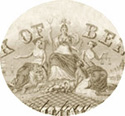
No comments:
Post a Comment